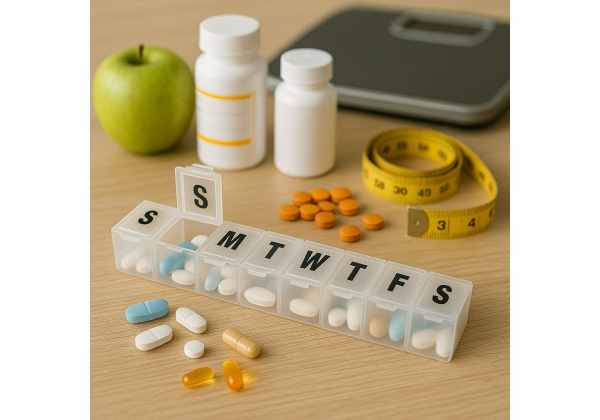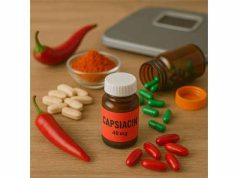
Medications can lower appetite, quiet food noise, and help you hold a calorie deficit. Diet and exercise protect muscle, improve energy, and make results stick. The best outcomes come from using both on purpose—not hoping pills will replace habits or that willpower alone will outpace biology. This guide shows how to pair medications with practical nutrition and training, what results are realistic, and how to maintain them. If you are weighing supplements, prescriptions, and non-surgical options side by side, start with our overview of evidence-based medical and supplement tools for weight management to see where each piece fits.
Table of Contents
- Do medications plus diet and exercise work better?
- Realistic results by medication class
- How to build the plan week by week
- Preventing muscle loss during weight loss
- Common mistakes and troubleshooting
- Safety, monitoring and who should avoid
- Maintaining results after stopping or continuing
- Frequently asked questions
Do medications plus diet and exercise work better?
Pairing medications with structured habits is not “belt and suspenders”—it is how modern care works best. Medications lower the biological pressure to eat; diet and exercise determine what weight you lose (fat vs. muscle) and how well you keep it off.
Why the combo outperforms either alone
- Appetite vs. adherence: Medicines reduce hunger, cravings, and intrusive food thoughts. That frees up attention for shopping, meal structure, and training—so your plan is easier to follow for months, not days.
- Quality of weight loss: Without resistance training and sufficient protein, any rapid loss includes muscle. Medications can create a larger deficit; training and protein protect lean mass so your resting metabolism stays higher.
- Metabolic health: Exercise and fiber-rich eating improve insulin sensitivity, lipids, blood pressure, and sleep—benefits you want regardless of the number on the scale.
- Maintenance rehearsal: Habits you practice while losing weight are the same habits that hold the line later. Medications create a calmer environment to practice those routines.
A simple model of shared roles
- Medications: turn down appetite, slow gastric emptying, and tame reward pathways. Expect steadier portions and fewer binges.
- Diet: sets the macronutrient pattern—protein first, vegetables and fiber next, then starch and fats in measured amounts.
- Exercise: provides the stimulus to keep or build muscle, improve mood, and widen your “calorie budget” without relying on hunger.
Expected ranges with the combo
- With a GLP-1 or similar agent plus protein-forward eating and two to three strength sessions weekly, many patients see 8–15% total body weight loss (TBWL) over 6–12 months, sometimes more with higher-potency medicines and excellent adherence.
- With older agents (e.g., orlistat, naltrexone-bupropion, phentermine-topiramate) plus a structured plan, 5–10% TBWL in the same window is common.
- Lifestyle alone can absolutely work—5–10% TBWL is a strong, health-changing outcome—but medications increase the probability and consistency for people with strong biological drivers of weight.
If you are beginning from scratch, skim our hub on safe, sustainable weight loss basics to anchor your plan before you add medication.
Realistic results by medication class
Choosing a medication is not about chasing the highest average loss. It is about matching medical history, side-effect profile, access, and goals—then pairing it with a plan you can keep. Below are common classes and typical expectations when combined with diet and exercise.
GLP-1 receptor agonists (e.g., semaglutide) and dual-incretins (e.g., tirzepatide)
- Mechanism: amplify meal-time satiety signals, slow gastric emptying, reduce food noise.
- Typical TBWL with habits: 10–20% over 6–12 months; higher end with dual-incretins, structured protein, steps, and resistance training.
- Upsides: strong appetite control; metabolic risk factors often improve.
- Watch-outs: nausea if portions are large or rushed; constipation without fiber and fluids; need for slow dose titration and consistent meal pacing.
- Learn more: see a plain-language overview of GLP-1 medicines and what to expect.
Phentermine-topiramate (combination)
- Mechanism: reduces appetite and food reward; may improve portion control.
- Typical TBWL with habits: 8–10% over 6–12 months.
- Watch-outs: paresthesias, dry mouth, mood or sleep changes; avoid in pregnancy (strict contraception required).
Naltrexone-bupropion
- Mechanism: targets reward pathways and cravings; helps some curb emotional eating.
- Typical TBWL with habits: 5–8%.
- Watch-outs: nausea, headache, sleep disturbance; avoid with seizure risk, uncontrolled hypertension, or certain psychiatric histories.
Orlistat
- Mechanism: blocks fat absorption; works only when fat intake is present.
- Typical TBWL with habits: 5–7%; more if paired with lower-fat, high-fiber meals.
- Watch-outs: GI side effects if fat is high; requires fat-soluble vitamin supplementation.
Metformin (off-label for weight)
- Mechanism: improves insulin sensitivity; appetite effects are modest.
- Typical TBWL with habits: 2–5%, most in people with insulin resistance or PCOS.
- Watch-outs: GI discomfort early on; rare B-12 deficiency with long-term use.
Key selection principles
- Match the driver: If constant hunger and large portions are the issue, incretin-based therapy fits. If emotional snacking dominates, naltrexone-bupropion may be better.
- Start low, go slow: Titrate to the minimal effective dose that maintains appetite control without side effects.
- Plan the food environment: Protein and fiber at meals, slow eating, and pre-planned snacks reduce side effects and increase success.
- Rehearse maintenance early: Track behaviors (protein, steps, training, sleep) alongside weight from day one.
How to build the plan week by week
Think in 12-week blocks. That is long enough to build durable routines and short enough to keep focus high. The outline below assumes you are starting or titrating a medication while building habits.
Weeks 0–2: Baseline and setup
- Medical setup: confirm indications, review meds, screen for contraindications, and align expectations (e.g., “Our target is 10% in 6–12 months with muscle preserved”).
- Metrics: weight, waist, blood pressure, morning energy, step count; optional photos and a brief hunger log (0–10 scale before and two hours after meals).
- Food defaults: set a simple plate rule—protein first (20–40 g), a fist of vegetables, then starch/fat if still hungry.
- Grocery list: lean proteins, Greek yogurt or cottage cheese, eggs, legumes, frozen vegetables, high-fiber grains, fruit.
- Training: two full-body sessions/week (push, pull, hinge/squat, carry), and daily steps—choose a sustainable baseline.
Weeks 3–4: Dose finding and rhythm
- Titrate to the lowest dose that calms hunger without nausea.
- Meal pacing: smaller bites, 15–20 minutes per meal; stop at comfortable fullness.
- Protein scaffolding: make breakfast and one other meal protein-anchored every day. If mornings are hard, a ready option helps; see fast options in protein shake planning.
- Cardio: add two easy sessions (20–30 minutes zone 2 or brisk walks).
Weeks 5–8: Add precision, not complexity
- Protein target: most do well at 1.2–1.6 g/kg/day (or 0.6–0.8 g/lb).
- Fiber: aim for 25–35 g/day (beans, lentils, oats, chia, psyllium).
- Strength: move to three sessions/week, progressive overload (slightly heavier, more reps, or another set).
- Sleep: protect a 7–9 hour window; caffeine curfew 8–10 hours before bed.
- Review side effects: constipation → more fluids/fiber; nausea → smaller, slower meals; reflux → avoid late large meals.
Weeks 9–12: Consolidate and rehearse maintenance
- Eating out script: protein and vegetables first; split starch; order slowly.
- Travel script: pre-pack protein, plan walking, schedule brief hotel-room sessions.
- Checkpoints: weight trend, waist, strength numbers, resting energy, hunger scores.
- Decide: dose steady vs. further titration; identify two habits that carried you most—keep those non-negotiable.
What success looks like by week 12
- Hunger is predictable and calmer.
- You can list three default meals that work in busy weeks.
- You have two workouts you can perform anywhere, plus a consistent step range.
- The scale trend is down while major lifts are stable or up.
Preventing muscle loss during weight loss
Preserving lean mass is the difference between “lighter” and “healthier.” Muscle protects joints, supports glucose control, and keeps resting metabolism higher. Medications make calorie deficits easier; training and protein decide what tissue you lose.
Core pillars
- Protein: most adults do well at 1.2–1.6 g/kg/day; very active or older adults may benefit from the upper end. Distribute across 3–4 meals (≥25–35 g each).
- Resistance training: two to three full-body sessions/week. Prioritize compound lifts (squat/hinge, push, pull) with progressive overload. Keep a simple log.
- Creatine monohydrate: 3–5 g/day can support strength and training volume during a deficit; review details in creatine while losing weight.
- Adequate carbs around training: even modest carbs can support quality sessions and recovery.
- Sleep: muscle is built at rest; protect nights.
Signals you are losing muscle
- Strength numbers fall week to week despite adequate sleep.
- Persistent fatigue and rising resting heart rate.
- A sharp drop in calorie needs out of proportion to weight change.
Course correct quickly
- Taper the deficit (e.g., add 150–250 calories from protein and complex carbs).
- Hold medication dose steady while you re-establish training quality.
- Keep protein near the upper end of your range; spread it out.
Special considerations
- If nausea limits intake early in GLP-1 therapy, front-load protein earlier in the day and use lower-volume foods (eggs, yogurt, fish, protein shakes) until tolerance improves.
- If constipation appears, increase fluids, fiber, and walking; consider psyllium or magnesium if approved by your clinician.
Common mistakes and troubleshooting
Mistake 1: Expecting medication to replace meal structure
Without protein and fiber anchors, side effects rise and results fade. Keep a short list of default meals for busy days.
Mistake 2: Eating too little for too long
Over-restricting increases fatigue, plateaus, and muscle loss. Use a moderate deficit and adjust by outcomes, not by fear.
Mistake 3: Skipping resistance training
Cardio helps health and burn, but strength work protects muscle. Even two 30-minute sessions/week make a clear difference.
Mistake 4: Ignoring sleep
Short sleep drives hunger and cravings and weakens training. Set a caffeine cut-off and a repeatable wind-down routine.
Mistake 5: Chasing stim stacks
“Fat burner” blends add jitter without better outcomes and can clash with prescriptions. Learn common red flags in fat burner risks.
Mistake 6: Not planning for side effects
- Nausea: smaller portions, slower bites, pause between courses, ginger tea.
- Constipation: 25–35 g fiber/day, 2+ liters of fluids, daily walks, stool softener if approved.
- Reflux: avoid late heavy meals; elevate head of bed if needed.
- Low appetite but low protein: use shakes, eggs, yogurt, tender fish; season generously to improve palatability.
Troubleshooting plateaus
- Confirm adherence (meals, steps, training, sleep) for two weeks.
- Adjust one variable: tighten calorie drift, add a training set, or add 1,000–2,000 steps/day.
- Consider a diet break (at maintenance calories) for 7–10 days to restore training quality, then resume.
Safety, monitoring and who should avoid
Medications are tools—powerful, but not for everyone. Proper screening and follow-up keep benefits high and risks low.
Before starting
- Review medical history, current meds, pregnancy plans, mental health history, and blood pressure.
- Baseline labs as directed (e.g., A1c, fasting lipids, liver/kidney function when indicated).
- Discuss expectations: likely time frames, side effects, and how diet and training reduce them.
Follow-up cadence
- First 8–12 weeks: more frequent check-ins to titrate dose and tame side effects.
- After stabilization: every 8–12 weeks to review weight trend, waist, appetite, training, sleep, and labs when needed.
- Track behaviors (protein, steps, sessions) alongside weight to spot early drift.
Who should avoid or use with caution (varies by agent)
- Pregnancy or trying to conceive: avoid most agents; discuss timelines to stop before conception.
- Breastfeeding: many agents are not recommended.
- Uncontrolled hypertension or arrhythmia: stimulants and some combinations are inappropriate.
- Seizure risk or eating disorders: some agents (e.g., bupropion-containing) are contraindicated; specialized care is essential.
- Severe GI disease or pancreatitis history: review carefully with your clinician, especially for incretin-based therapies.
- Advanced kidney or liver disease: require tailored choices and monitoring.
Drug interactions to respect
- Beware of stacking stimulants, adding over-the-counter “fat burners,” or combining multiple glucose-lowering agents without coordination.
- If you take thyroid replacement, anticoagulants, or psychiatric medications, confirm compatibility and timing.
Informed choice matters
If medication is appropriate, you can further orient yourself in our plain-language guide to who qualifies for weight loss medicines and how they work. Always personalize decisions with your healthcare professional.
Maintaining results after stopping or continuing
Weight biology does not “reset” at goal weight. Appetite and energy expenditure shift as you become lighter. Maintenance works when you assume biology will push back—and you plan for it.
If you continue medication
- Hold the lowest dose that keeps appetite calm and side effects minimal.
- Shift focus to performance goals (steps, strength PRs, sleep streaks) and waist maintenance, not to ever-lower scale numbers.
- Schedule maintenance reviews every 8–12 weeks: Are habits stable? Can the dose step down?
If you taper or stop
- Expect some hunger return. Protect protein and strength training; keep two high-satiety meals daily.
- Use boundary behaviors: kitchen closed after a set time, pre-logged snacks, no liquid calories at home.
- Track trend metrics: a 1–2% uptick from your maintenance range triggers a two-week tune-up (tighten meals, add steps/sets, revisit sleep).
Relapse prevention
- Keep easy wins visible: ready-to-eat protein, frozen vegetables, pre-cooked grains, fruit bowl.
- Plan for high-risk weeks (travel, holidays) with “good-enough” defaults rather than perfection.
- Consider periodic coaching or groups; accountability supports maintenance.
When to consider a different path
- If you need larger, faster risk reduction (e.g., severe obstructive sleep apnea, advanced fatty liver) and struggle despite full adherence, discuss surgical options with your team. The same habit scaffolding applies pre- and post-procedure.
The maintenance mindset
You are not trying to be “on a diet forever.” You are choosing a repeatable lifestyle where protein, vegetables, steps, strength, and sleep are routine—and medication is a calibrated assist when useful.
Frequently asked questions
How much weight can I realistically lose by combining medication with diet and exercise?
With a GLP-1 or dual-incretin plus structured habits, many see 10–20% body weight loss in 6–12 months. With other agents and strong habits, 5–10% is common. Your medical history, dose, adherence, and training quality shape where you land.
Do I need a perfect diet to start medication?
No. Start with protein-first meals, vegetables, and slower eating. Medications calm appetite so those basics feel manageable. As side effects settle, refine portions and add fiber. Aim for consistency, not perfection, in the first month.
What kind of exercise works best on these medicines?
Two to three full-body strength sessions plus daily steps is the highest-leverage mix. Add easy cardio for heart health and recovery. Protecting muscle is non-negotiable; it keeps metabolism higher and supports long-term maintenance.
Can I stop medication once I reach goal weight?
Possibly, but plan for hungry weeks as you taper. Keep protein high, maintain training, and set boundary behaviors. If hunger becomes unmanageable and regain starts, continuing at a lower maintenance dose may be appropriate—decide with your clinician.
What should I do if I plateau?
Confirm the basics for two weeks: protein at meals, fiber, steps, training, and sleep. Then change one variable—tighten calorie drift, add 1,000–2,000 steps/day, or add a training set. Consider a brief diet break to restore training quality, then resume.
Are “fat burner” supplements helpful with prescriptions?
Generally no. They add stimulation and side-effect risk without better results. If you use prescription therapy, keep supplements simple and well-vetted, and avoid stimulant blends marketed for rapid fat loss.
References
- AGA Clinical Practice Guideline on Pharmacological Interventions for Adults With Obesity 2022 (Guideline)
- Tirzepatide Once Weekly for the Treatment of Obesity 2022 (RCT)
- Continued Treatment With Tirzepatide for Maintenance of Weight Reduction in Adults With Obesity: The SURMOUNT-4 Randomized Clinical Trial 2024 (RCT)
- Systematic review and meta‐analysis of protein intake to support muscle mass and function in healthy adults 2022 (Systematic Review)
- Common questions and misconceptions about creatine supplementation: what does the scientific evidence really show? 2021 (Review)
Disclaimer
This article is educational and does not replace personalized medical advice, diagnosis, or treatment. Decisions about starting, stopping, or changing any medication or supplement should be made with your healthcare professional, considering your medical history, current prescriptions, and goals.
Share and follow
If this guide clarified how to combine medication with practical nutrition and training, consider sharing it with someone building a plan. For steady, evidence-based updates on weight, nutrition, and metabolic health, follow us on the social platform you use most—Facebook, X, Instagram, or LinkedIn.










